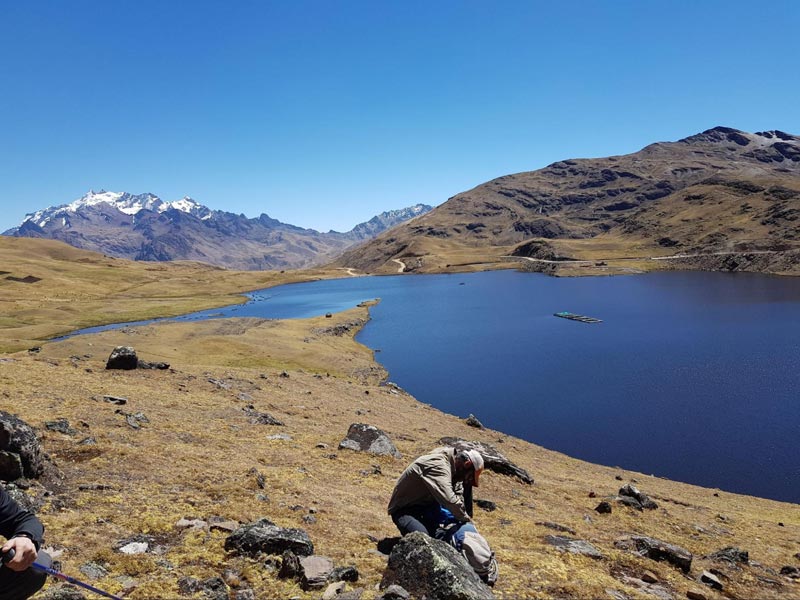
My first hike in the Peruvian Andes was a birthday present from my wife, Alessandra. She hired Franco from La Base in Lamay to take me and a friend on a daylong loop of lakes and vistas in the mountains above Lamay. Best present ever.
Andean hiking has been my drug of choice ever since. Sure, I’ve hiked in California’s Sierras, in Canada and in the Middle East (Mount Sinai, the West Bank, the Israeli Negev), but since we moved to Peru’s Sacred Valley three years ago, world class, high-altitude trails have been calling out and I respond as often as I can.
Here’s a list of my seven priorities for day hiking in Peru. Much of this applies to multi-day hikes as well. Read on to help you trek with confidence.
Seven Priorities for Day Hikes
- Priority one is your feet.
- Priority two is hydration.
- Priority three is staying dry.
- Priority four is preparation.
- Priority five is navigation.
- Priority six is proper gear.
- Priority seven is hiking companions.
1. Priority one when hiking in Peru is your feet.
Your feet do most of the work and deserve your love and respect. Unless you’re just going for a stroll, you’ll be glad for good hiking shoes and socks.
Trim your toenails before you leave, and never ignore hotspots or overheating along the trail. The problem will only get worse if you wait until lunch.
Moleskin works magic. Some folks even apply it before they set out; I prefer to wait until problems arise.
2. Priority two is hydration.
In dry climates it’s easy to dehydrate without realizing it. You don’t want a headache at altitude. I carry two reusable water bottles: a 1L Nalgene and a 750 ml CamelBak Chute. There are plenty of options to help you say No! to disposable plastic. Instead of carrying Gatorade, replenish your electrolytes (Calcium, Potassium, Sodium, etc.) with soluble powder or tablets.

Depending on the length of your day hike, you might want to pack a water filter to remove floating pathogens, bacteria and other nasties from the streams and springs you pass. I have a 24 oz. (710 ml) Grayl which gets great reviews, but since it weighs in at 15.9 oz (450 g) I’m hoping to find something lighter.
Keep in mind: if you hike between June and November and your route is dry, you’ll have only the water you carry.
3. Priority three is staying dry.
Cotton is comfy, but rain or sweat turns it into a cold sponge. So don’t hike in jeans and cotton Ts. Layer up instead with merino wool, polyester and other quick-drying materials; even when wet you’ll stay warm.
In the Andes most rain comes between November and April. If you don’t have a good rain shell / windbreaker you could be in trouble.
4. Priority four is preparation.
You should probably accustom yourself to the altitude of the Sacred Valley (3K meters/10K feet above sea level) or Cusco (3,400 meters/11,200 feet) before attempting hikes that take you higher. I’ve reached 5,100 meters (on a multi-day), but most day hikes in Peru won’t take you higher than 4,000 meters.
For last-minute outdoor shopping, Tatoo has stores in Cusco and Lima. A few other shops in the Sacred Valley (e.g., Ulrike’s Cafe in Pisac) have hiking supplies but inventory is limited.
Pick your route. For a route both simple and gorgeous, hike from Huaran to Cancha Cancha and back. Have a taxi or tuk tuk take you from the highway to the end of the road above Huaran, where the trailhead is clearly marked. From there the trail is obvious, mostly following a glacial stream.
At 4K meters, the village of Cancha Cancha is home to llama and sheep herders whose flocks and herds you encounter along the way. En route you’ll enter groves of my favorite Andean tree: the gnarly evergreen Queñua or polylepis.
Protected by red, flaky bark, this magical tree thrives between 3,500 and 5,000 meters above sea level, making it the tree with the highest natural habitat in the world. The fact that it uses 5% as much water as the non-indigenous, water-sucking eucalyptus should make it everyone’s favorite.
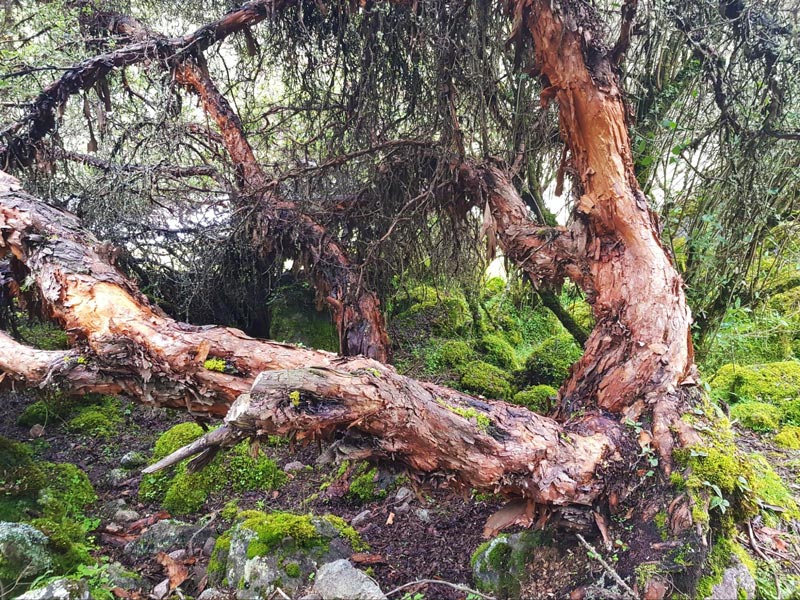
Queñua or polylepis
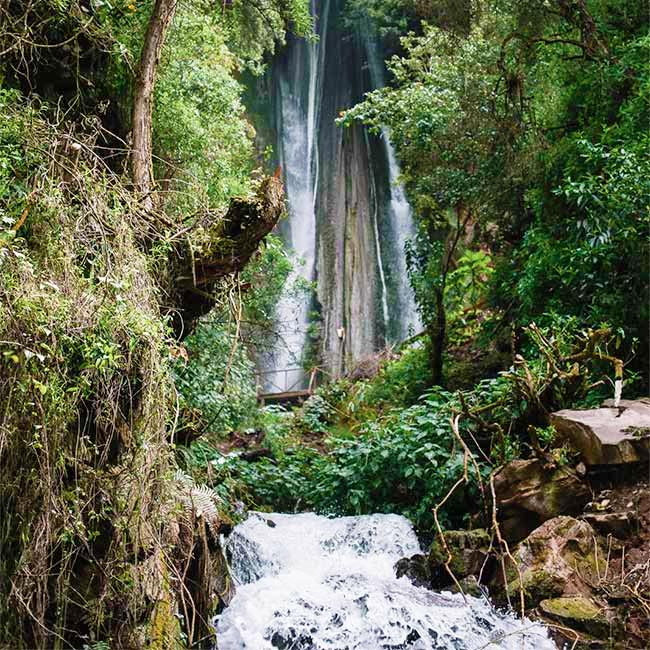
Poq Poq waterfall
Another great (and less demanding) day hike descends from the majestic Inca terraces of Chinchero along an ancient path (the Q’apaq Ñan) to the Poq Poq waterfall and eventually the village of Urquillos on the Urubamba river.
If you walk with Sonia and Freddy you’ll enjoy a delicious lunch at a charming rest stop below the falls. This delightful one-way, down-hill, half-day nature encounter is perfect for families.
Leave your itinerary with a friend. CleverHiker’s itinerary template has good ideas though it’s more elaborate than you need.
Know when the sun sets. Here at 13 degrees south of the equator the sun probably sets faster and sooner than where you live: around 6:15pm in January, and 5:30pm in June. If your hike will fill the whole day, start early-early so you don’t finish in the dark.
Weather changes quickly–as I type it’s sunny, but a storm (or a light shower) could appear in a few hours. The higher you hike, the less predictable. Check the forecast in advance but don’t be surprised if there’s a surprise.
5. Priority five is navigation.
Most day hikes won’t require a navigation app, but it never hurts to have a few on your phone. I map longer routes on my computer, load them to my phone, share them with fellow-hikers, and email them to a friend who’s staying home. I may or may not have eight navigation apps on my phone. 😁
Check out the top two.
- Gaia Gps: “Maps for Every Adventure”
- Maps.me (A Palestinian trekking friend showed me this one. Learn more here: How to use Maps.me like a pro)
- Wikiloc: “Trails of the World”
- FATMAP
- GraphHopper
- GPX Viewer
- All Trails
- Google Maps
I’ll have one or two apps running during a hike. Watch for battery drain. You may lose phone service, but GPS will still work. Also handy are compass and barometer apps. Sky-Map is my go-to for navigating the (light-pollution-free) Andean heavens, but I digress.
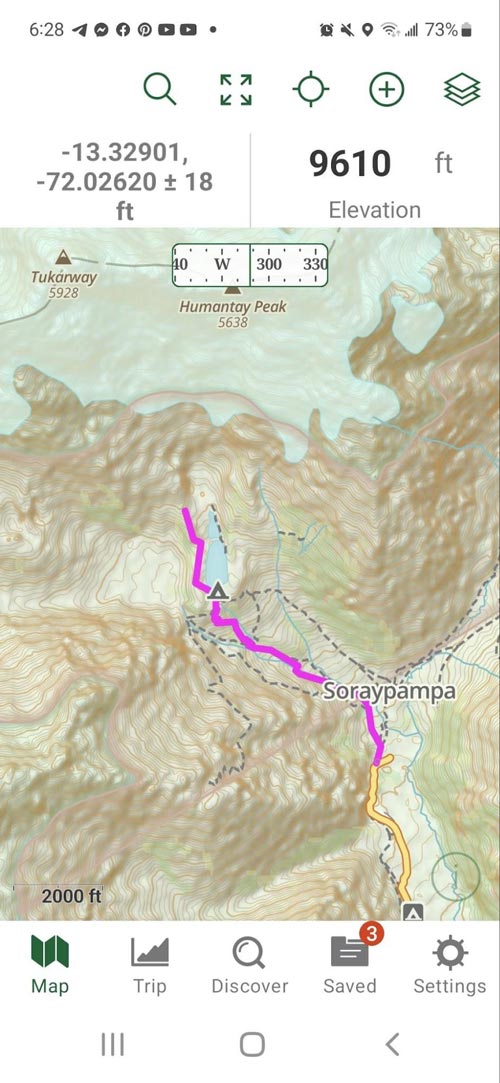
6. Priority six is proper gear.
In addition to shoes, socks, water bottles and filters already mentioned, here’s what else I would bring.
- day pack: I’m an Osprey fan.
- trekking poles: they’ll save your knees on descent and stabilize you crossing streams.
- wind/rain shell
- layers (quick-dry, non-cotton)
- shade hat and warm hat
- gloves or mittens
- sunglasses and sunscreen
- pocket knife
- first-aid kit
- duct tape or Tenacious Tape
- toilet paper and bag to pack out all paper and plastic
- energy snacks and lunch
- local money: in case you encounter women selling textiles, or enter a protected area that charges a small fee
Optional bits and pieces:
- The Deuce potty trowel (Pack out dirty TP but bury waste, away from the stream.)
- fleece or insulated vest
- flashlight or headlamp
- matches or lighter (at altitude there isn’t much firewood)
- coca leaves (to chew and to share with locals)
- emergency blanket (think Chuck in Better Call Saul)
- travelers insurance (like this)
- dog (If I hike, they hike.)
If you arrived by plane you probably left your dog at home. If you are lucky enough to have pup with you, here are canine tips for no extra charge:
- Food and snacks: dogs burn more calories hiking than they do lying around the house. (Duh.) Moca wears a pack so I don’t have to carry her food or Ccino’s.
- Bring a water dish if your path doesn’t follow a stream; some recommend filtering the dog’s water; I let mine drink freely from streams, springs and lakes.
- No need for dog boots in Andean terrain.
- Pack a short length of rope: leash up if you encounter sheep/llamas and pup wants to “play.”
- You’ll find everything about hiking with dogs here.
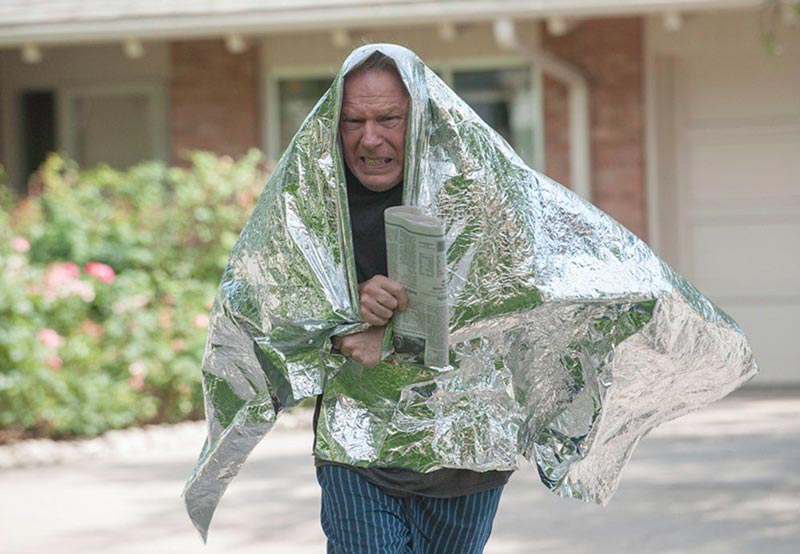
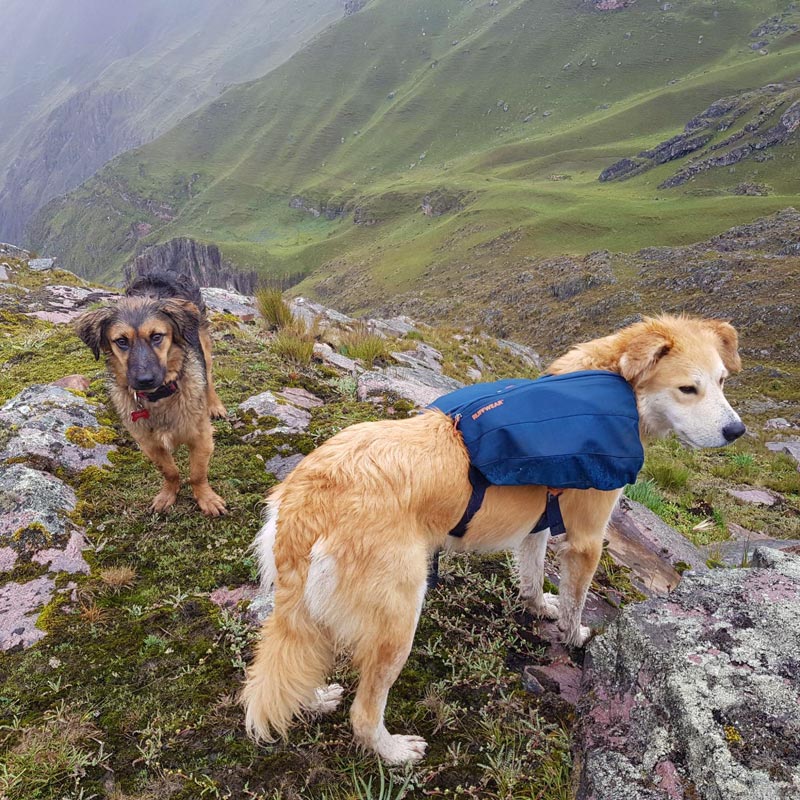
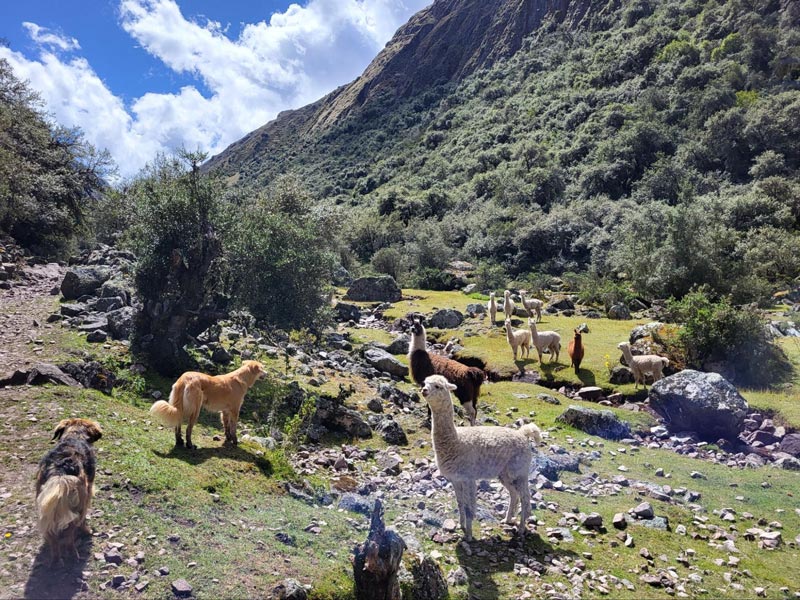
7. Priority seven is hiking companions.
Some of my friends hike solo and do fine. I don’t. Besides my canine companions, I don’t hike the Andes without at least one other trekker, maybe two. (I max out at four.)
I don’t want constant chatter, just intermittent genial conversation. It’s fun to celebrate a summit or trade stories as the sun sets.
Hiking with buddies is less important on an out-and-back day hike, and sometimes we crave me time. But these mountains are vast and wild. If you get hurt or stuck, it could take a while before someone finds you (recall Priority Four). Happily, most trails are obvious if rarely marked—except perhaps by organic souvenirs left by llamas, sheep and donkeys—so getting lost on a day hike is unlikely.
Take Your Time
Whether you hire a local guide—a modest expense in this part of the world—or chart your own Andean adventure, I hope you take your time.
Take your shoes off by the stream. Catch your breath. Inspect the lichen. Don’t forget to look up.
Cherish all encounters along the trail. Share your coca leaves. Pause in the villages where weavers, herders and farmers are preserving traditions older than the Incas. Converse using gestures. Sample their potatoes. Buy alpaca mittens from the artisan who made them.
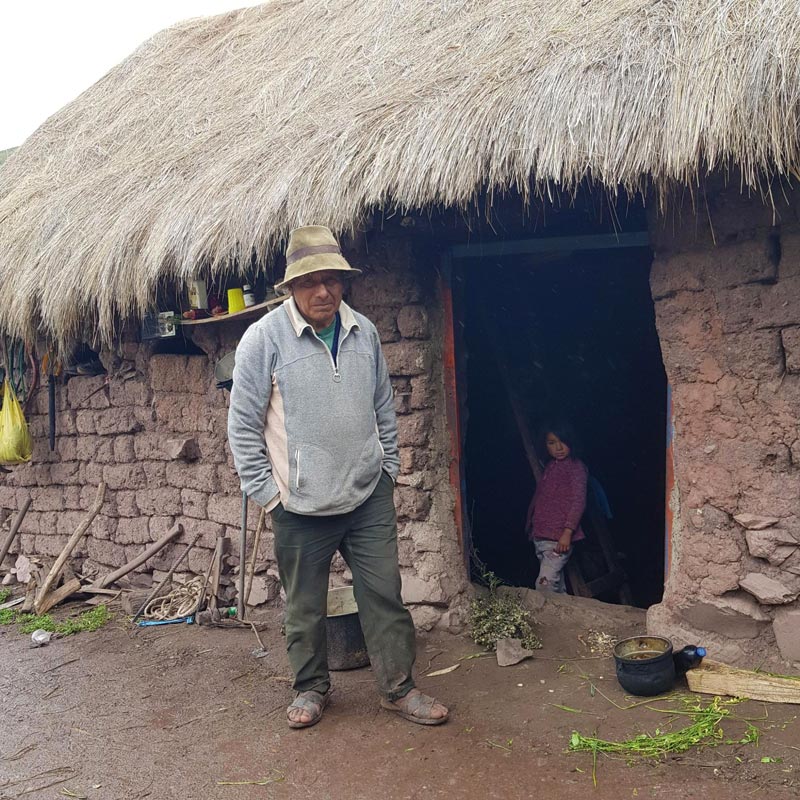
Hiking Peru with Curios
To all who are physically able I say: every visit to Peru should include a day hike or two. Risks are few and rewards are spectacular.
Several Curios experiences are perfect for day hikers:
- I mentioned earlier the delightful waterfall hike from Chinchero to Urquillos with Freddy.
- To hike the Inca terraces of Yucay (my favorite terraces in the Valley), go with Ursula, a visual anthropologist.
- To combine a hike with relaxation, meditation and exhilarating water immersion, join yoga instructor Gonzalo in Cusco.
- For a gentle hike and picnic lunch in the hills above Urubamba, join naturalists and their llamas.
So many opportunities await!
FOOTNOTE: Want more wisdom from trekking experts? Visit Megs at Packing up the Pieces, Dave and Annie at CleverHiker, and The Broke Backpacker team, where you’ll find longer checklists, gear reviews, suggested routes, tips for responsible travel, and great advice. I’m not earning a penny for linking to these sites. For other hike routes, the Peru Travel Guide on Megs’ Packing up the Pieces is a trove of ideas, routes, maps and tips.



